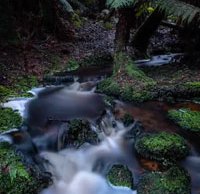How to capture multiple shots to properly expose shadows and highlights
posted Monday, August 13, 2018 at 9:00 AM EDT

Photographer Andrew Marr is on a Tasmania photography adventure with a couple of other photographers, Andrew Dawes and Richard Lefroy. Below, we see the first video from his trip. The trip is focused on landscape and nature photography in particular. The first stop on the trip was Mount Fields National Park, which included a sunset hike to Lady Barron Falls.
The location, while very nice, proved challenging due to the extreme contrast in the scene. While you can often recover shadow detail from a scene, even if that means introducing noise, if you completely blow a highlight in a RAW file, it's typically gone forever with no hope of recovery. It's important to note here that a highlight can be blown on your camera, which is showing you a JPEG image, and not be lost in the RAW file you process later.
Realizing that the scene would not work with a single exposure and that filters wouldn't solve the issue either, Marr decided to capture multiple exposures to ensure that he was able to retain both shadow and highlight detail in the high-contrast composition. Using a Nikon D850, which Marr just recently purchased, and a Nikon 17-35mm lens, he shot at ISO 100 and f/16. The image he'd eventually use for the darker parts of the scene was shot at 5 seconds. For the water, he shot a 1-second exposure. Finally, for the brightest portion of the frame, Marr used a 0.5-second shutter speed. He then took the images and merged them in Lightroom to create the final image. Check him out in action in the video below.
(Via Andrew Marr)